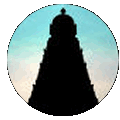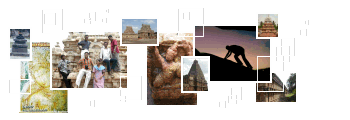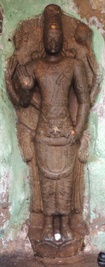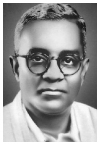 |
 |
 |
http://www.varalaaru.com A Monthly Web Magazine for South Asian History [187 Issues] [1839 Articles] |
 |
 |
 |
http://www.varalaaru.com A Monthly Web Magazine for South Asian History [187 Issues] [1839 Articles] |
|
Issue No. 137

இதழ் 137 [ செப்டம்பர் 2017 ] 
இந்த இதழில்.. In this Issue.. 
|
Chandrasekaraswami Temple or Thiruchchendurai Karrali Mahadevar Temple INSCRIPTIONS Fifty two inscriptions are found in this temple complex that gives us valuable and interesting information on various aspects in the temple and region viz., the activities of the sabha ‘Mulapparudaiyar’, temple administration, land revenue administration, administrative divisions, royal people, officials, common man etc. Among the fifty two inscriptions forty-four belonged to the Cholas of various periods, two belonged to the Vijayanagar period, six inscriptions lack author name. Among the forty-four Chola inscriptions except seven the rest belonged to the Early Chola period. Nearly twenty inscriptions refer ‘the Velirs’ which help us to understand the strong alliance of the Cholas-Velirs in the early medieval period and the region under the administrative control of the Velirs under the suzerainty of the Cholas. Fourteen inscriptions refer Pudi Adhichchapidari, about her various forms of endowments that she made to the god and the temple she had constructed. The inscriptions of Thiruchchendurai karrali Mahadevar koil give us a good glimpse on the early medieval society in the Chola country. THE DEITY IN THE INSCRIPTIONS The early inscriptions mention the deity as ‘Karrali Mahadevar’ and the temple as ‘Thiruchchendurai Karrali Mahadevar Koil’. The Princess Pudi Adichcha Pidari in few of her inscriptions specifically stated that ‘Nan edupitha Karrali Mahadevar koil’. The later Chola inscriptions mention the deity as ‘Thiruchchendurai Karrali Parameswarar’, ‘Thiruchchendurai Karrali Perumanadigal’. Inscriptions that belong after C.E. 13th century mention the deity as ‘Udaiyar Thiruchchendurai Udaiyar’. The C.E. 16th century inscriptions (ARE 1937-38: 148) mention the deity as God of Thiruchchendurai. ‘Chandrasekaraswami’, the present name of the deity is not found in the inscriptions. PUDI ADICHCHA PIDARI Fourteen inscriptions refer Pudi Adichchapidari and her various endowments to Karrali Mahadevar. The 3rd regnal year inscription of Parantaka I (625) introduce Pudi Adichchapidari as daughter of Tennaval Ilangovelar alias Maravan Pudiyar, the Velir chief and queen of Arikulakesari, son of the Chola king Parantaka I. Besides, three inscriptions (625, 626, 628) attested the stone Siva temple was constructed by her. A Parakesari inscription (625) speaks about her 60 kalanju of gold endowment for sacred offerings, another inscription (608) speak about her purchase of land for gold for perpetual lamp. Inscriptions (618) also speak about purchase of land from Parudai to be endowed to God. Few inscriptions (604, 619, 628) also speak about purchase of land from individual for various purposes of endowment to the temple. One of her inscription (629) speaks about gift of 6ma of land as ‘thattamilpuram’ for the Uvachchars (percussionists) of the temple. Few inscriptions (601, 620, 621) speak about gift of gold for tax remission to temple land or safeguarding the taxes for the temple. The inscriptions glean Pudi Adhichcha pidariyar a philanthropist, she not only constructed the temple but also continuously and enormously endowed to this temple. administrative Divisions The Early Chola inscriptions refer Thiruchchendurai, a suburb of Isanamangalam, a brahmadeya in Uraiyur Kurram. The valanadu is gleaned for the first time through the Rajendra Chola I (SII 8:613) inscription which refers the Uraiyur kurram under Keralanthaga Valanadu, Keralanthagan being a title of Rajaraja I. The brahmadeya Isanamangalam in Uraiyur Kurram was added with the status of Chaturvedimangalam in the later period which is gleaned through the inscriptions of Kulottunga I (SII 8:622) and Vikramachola (SII 8:606). The inscriptions refer Thiruchchendurai as ‘Virudhuraja bayangara chaturvedimangalam’ and came under the administrative division of Rajamahendra Valanadu, ‘Virudhuraja bayangara’ being the title of Kulottunga I. Again two inscriptions in C.E. 13th century characters (ARE 1972-73:347) indicate the changeover in valanadu, were Thiruchchendurai came under the Rajagambiran Valanadu. But the inscriptions of Vijayanagar period simply stated Thiruchchendurai. An interesting information for consideration is that, two Early Chola inscriptions (SII 8:612, 604) mention the Isanamangalam with the phrase ‘Uraiyur Kurram Ninru Thuninthu Poya tharamparrur nattu padai eviya brahmadeyam Isanamangalam’. VILLAGES GLEANED THROUGH THE INSCRIPTIONS Idaiyarrunadu (617), Karuppur Nadu (622), Urattur Kurram (602, 616, 617, 618), Thanjavur Kurram (612) are the other Nadu, Kurram divisions gleaned through the inscriptions. Vedelvidugumangalam (8: 607, 612, 619), Sattamangalam in Idayarunadu (617) are the other brahmadeyas pictured by the inscriptions. The other villages known through the inscriptions are Thirupoodesvaram of Kodumbalur in Urattur kurram (8: 602) Allur (8:600) and Amankudi (630, 632) in Uraiyur Kurram, Isananmangalam (8: 609), Kodumbalur and Kizhlvelur (8:617) in Urattur Kurram (8:616) and Thanjavur in Thanjavur kurram. Thirupparaitturai, Tattamilpuram in Karuppur Ur. Muttur village in Vallanadu, a subdivision of Pandi mandapalam, Sendankudi, Rajagambiranallur, Thiruvellarai are also referred in the inscriptions. MULAPPARUDAIYAR - THE LOCAL ADMINISTRATIVE BODY The earliest available inscriptions (SII 8: 633, 634, 636) of the temple itself mention the village as a brahmadeya. Since a brahmadeya the village was under the administrative control of the Sabha which was popularly known as ‘Mulapparudaiyom’ or ‘Parudai’. Nearly seventeen inscriptions throw light on the various activities of ‘Parudai’. It carried out jobs like sale of lands, remittance of taxes after accepting a whole sum amount and agreed to carry out stipulated services at the temples on the endowments entrusted with them. It is interesting to note that no inscription refer any individual name of the Parudai, which indicate it as a collective body. Further, to authenticate it, two inscriptions refer the Parudai with its strength as ‘Nanuruvar Isanamangalam mulapparudaiyar’ (SII 8:600) ‘ivvur parudaiyana nanurroruvarom’ (SII 8:633). Several inscriptions speak about the sale of land by the Parudai. An inscription of Parakesarivarman (SII 8:605) attested the sale of land as tax free by Parudai after accepting 28 kalanju of gold from the purchaser. The taxes remitted include irai, echchoru, vetti. Parudai land mentioned in two of the (SII 8:634, 635) inscriptions help us to understand that the Parudai owned its own land. An inscription (SII 8:618) reveals the sale of Parudai land to Pudi Adichchapidari for 7½ kalanju of gold. The record has been written on the instruction of the Parudai by Anikalan Kaliadakki on behalf of Thesavalluvan, the Thinai officer, who is in service of the Parudai. The remission of taxes is well known through the inscription of Rajakesarivarman (611). Virachola Ilangovelar (a) Orri Mathuranthagan, the Velir Chief gave gold 100 kalanju on 1 ½ veli of land belonged to the temple. Parudai accepted the amount and remitted the taxes echchoru, vetti, kulai and kudi. The agreement was signed by Nagathudaiyan Marthandan, the brahma perunthinai, a revenue officer of the village. Another inscription (621) speaks about remission of taxes by Mulapparudai for the certain portion of land purchased and gifted to the temple by Pudi Adhichcha pidariyar after accepting 37 ½ kalanju of gold from her. Another inscription (636) speaks about a piece of land purchased from Parudai for 40 kalanju of gold by Pulalaya chetti and gifted to the deity of Puzhaya vinnagar. Again the land was made tax free after accepting 70 kalanju of gold from the Chetti. The Mulapparudai as an administrative body also accepts endowments entrusted with them agreeing to carryout the stipulated services. An early record (615) of Parakesarivarman registers an endowment of 20 kalanju of gold by Nakkan vikramakesari,, queen of Tennavan Ilagovel (a) Adittampudi for lighting the perpetual lamp for the Thiruchchendurai Perumanadigal. The job was accepted to carry by Parudai. ROYAL ORDER The royal order is termed as ‘Srimugam’, the Parudai received the ‘srimugham’ and entrusted to carry out the job as instructed. A Parakesari 23rd regnal year inscription (SII 8 : 616) speaks about a gift of iraiyili devadana as Devarpuram to Karrali Parameswarar, for this the Velir Chief Madhurantaka Irukkuvel and the SAbha carried out the job after receiving the Srimugam and also inscribed the same in stone. MEASURES We get ample information of gold, land, liquid measures that were in usage in the region through the inscriptions of Thiruchchendurai Karrali Mahadevar temple. An interesting information of this temple is that two land measures are found marked on the southern side of the central shrine i.e., vimana and the mukha mandapa. The measures are named as ‘Kuzhi kol’ and ‘Nilamalantha kol’ (Varalaaru 2). The former is exactly 90 cm and the latter is exactly 4 meters of length. The ‘Nilamalantha kol’ is cited in the Vadathirthanathar koil of Anthanallur a neighbourhood village (SII : 660). The inscription refers that the land had been measured using the rod referred in the Sri vimana of Thiruchchendurai Mahadever temple. Eleven inscriptions speak about gold endowment to the deity in which the gold measures viz., ‘Vedelvidugu kal’ and ‘Kudijnai kal’ are gleaned. Among the two the ‘Kudijnai kal’ is referred in only one inscription that belong to later period i.e., Rajendra Chola I period, whereas the rest of the inscriptions refer ‘Vedelvidugu kal’ which denotes it as a standard measure of the region in period prior to Rajendra Chola I. Sulakkaal, Thiruchchenduraiyan marakkaal are the paddy measures that prevailed in this region. It is interesting to find a paddy measure existed in the name of the presiding deity of the temple. ‘Sulanazhi’ and ‘Thiruchchenduraiyan nazhi’ are the smaller measures gleaned through the inscriptions. ENDOWMENT TO THIRUCHCHENDURAI KARRALI MAHADEVAR Endowments were made in the form of gold, cash and land to the Karrali Mahadevar. Among the three, the land endowment was enormous. Twenty six inscriptions speak about land endowments. Four inscriptions speak about the endowment of gold. Pudi Adichcha pidari endowed 60 kalanju of gold for thiruamuthu, the Parudai undertake the responsibility to carryout the endowment (SII 3: 96). The Velir Chief Udaiyar Virachola Ilangovelar (a) Orri Mathuranthagan gave 100 kalanju of gold for God, for this gold the Mulapparudaiyom agreed to remit all kind of taxes for 1½ veli of temple land (SII 8:611). Nakkan Vikramakesariyar wife of the Velir Chief Ilangovelar (a) Sembuthi’s endowed 20 kalanju of gold to burn a perpetual lamp, Parudai undertake the responsibility (SII 8:615). LAMP ENDOWMENT Twelve inscriptions speak about lamp endowment to the God. For burning lamp land endowment were also made. Parathayan Nakkan endowed a lamp to be burnt in the sanctum (SII 8 :600). Land purchased and endowed by Nakkan (a) Pokkiyan s/o Devanar of Thirupoodesvaram of Kodumbalur in Urattur kurram to burn a lamp (SII 8 :602). Nangai Pudi Adichcha Pidari purchased land and endowed for burning a perpetual lamp (SII 8 :608). Parathayan Nakkan kandan of Isanamangalam gave land to God for a nanda lamp to be burnt in the unnazhigai, i.e. sanctum and the job was entrusted to Mulapparudai. (SII 8 :609). Another inscription also speak about burning of lamp in unnazhigai but the source of endowment is lost. Certain Valayaganavati endowed three nanda lamps and to provide ghee for the lamps 30 cow, 12 buffalo, 100 goats are mentioned, further details are damaged. A lamp stand was also endowed. The job was entrusted to three siva brahmanas (SII 8 :610). Nakkan Vikramakesariyar wife of the Velir Chief Ilangovelar (a) Sembuthi’s endowed gold to burn a perpetual lamp, Parudai undertake the responsibility (SII 8:615). For burning lamps cash endowment also made. Varagurudaiyan Sorrunai Gangaisadai Karanthan deposited 10 kasu, a perpetual lamp had to be burnt with 1 ulakku of ghee which is met out of the interest recur out of the deposit. The job was entrusted to the koil sivabrahmanas. An inscription speaks about the sale of land for burning a lamp in the day (SII 8:617). Karuppurudaiyan Thiruvegamban sokkan gave 4 kasu to burn a perpetual lamp in the Thiruvanukkan Thiruvasal (SII 8:622). He also endowed for food offerings. Sembiyan Ilangovelar Pudi Adita Pidaran along with various offerings endowed a perpetual lamp (SII 8:624). Virachola Ilangovelar (a) Adittam Thiruvorriyuradigal endowed land for burning 12 lamps (SII 8:632). Thiruvarangamudaiyan venkatavan of Vaigasanar division got 5 kasu from Vellazhan Adichchan udaiyapillai of this village and agreed to burn a lamp in the evening called the Santhiyadeepam. FOOD OFFERINGS A Parataka I inscription (SII 3:96) speak about endowment of gold Pudi Adichchapidari for sacred offerings. 1 kuruni of rice pounded 10 or 8 times for sacred offerings in the dawn and mid-day. An inscription of Uttam Chola Pudi (SII 3:126) speaks about Adichchapidari purchased two gardens and endowed them as tiruvilappuram to meet out the expenses for the festivals on the day of solar eclipse. A 46th regnal year inscription of Kulottunga I (SII 8:622) speaks about the endowment of 45 kalam of paddy for the midday santhi (uchcham poluthu) to provide food for one maheswara (oru satti soru) made out of 2 nazhi of rice, for this they got 45 kalam of paddy. A 30th regnal year inscription (SII 8:624) king name lost speaks about various offerings like burning of lamp, food offering and ghee bath for deity. The endowment was made by Sembiyan Ilangovelar (a) Pudi Adita Pidaran for which he endowed lands as iraili devadana. Even the inscription details about the wages in the form of paddy to be paid for the people who employed during this services, for example, for 9 percussionists for panchama saptham, 1 segandigai etc. A 22nd regnal year inscription of certain Parakesarivarman (SII 8:627) speaks about the endowment of land by the Velir Chief Mathuranthaka irukkuvel (a) Aditta Pudi every month on the day of his natal star Poorattadi to perform sacred bath on ghee, on the day of sacred ghee bath gruel (ponagam) on pounded rice, neiyamirdu, banana, porikari, ilayamirthu and adaikkai amirthu. The annaprayam inscription of Adittam Pudi also details about various food offerings to Karrali Mahadevar and GAnavathiyar. It details about food offering for sirukalai and uchcham poluthu santhi. Appam for Ganavathi and thiruvamudu, paruppu, neiyamudu, thayiramudu – for all these measure of paddy is given. ANNAPRAYAM A 23 regnal year inscription of Parakesarivarman i.e. Parantaka I (Varalaru 2 and 21) gives us interesting information about the ceremony of giving first food to baby. The inscription refers it as Annaprayam. The velir chief Adittam Pudi made endowment of iraiyili land for food offering and worship on the day of annaprayam to his son Pudi Parantaka to the Karrali Mahadevar and Ganavathiyar. The land endowed was kudineekkiya devadana. This inscription help us to understand age old ritual still persist in the society. PUZHALAYA VINNAGAR Four inscriptions (SII 8 : 633, 634, 635, 636) are found in the adhishthana of the Sri Viswanatha-Visalatchi shrine. Among the four inscriptions three inscriptions (SII 8 : 633, 634, 636) speak about a Vishnu temple called Puzhalaya vinnagar. A Rajakesari inscription (SII 8:633) found on the southern base of the shrine speaks about the construction of a Vishnu temple by certain Puzhalaya chetti of Thanjavur, a Karnataka merchant and named it after him as Puzhalaya Vinnagar. The inscription details about the circumstances under which the temple had been constructed; Puzhalaya chetti aspires a charity that would benefit the society, the information was consulted with the ‘Parudai’ the Sabha of the Isanamangalam and in turn the sabha suggested for the construction of a Vishnu temple in the village. In addition, the sabha also accepted to carry the name of the shrine as Puzhalaya vinnagar, which supposed to be a stone vimana. The day of agreement itself was considered as an auspicious day and foundation was laid. The laying of foundation is also described in the inscription, a rare reference, the earth had to be excavated and the sand and water filled ground had to be leveled with the help of elephant. The inscription also further states that the deity had to be brought from the North and to be installed after performing the rituals. The inscription mentions the river Cauvery as the Ganges of South (Dakshinagangai). Besides, the status of the merchants is highlighted in the inscription as the one who were able to enter all the countries. One of the important fact gleamed through the inscription is that the strength of the ‘Parudai’ as four hundred and one. A 20th regnal year Rajakesari inscription (634) speaks about various arrangements between Parudai and Puzhalaya chetti viz., sale of land, remittance of taxes, gift of gold. The 12th regnal year inscription (635) of Rajatharaja speaks about endowment of lamp. The 8th regnal year inscription (No. 636, king name lost) speaks about the sale deed and endowment of land to Puzhalaya vinnagar. Though the above mentioned inscriptions of this shrine speak in detail about the construction of a stone vimana for Vishnu, naming it as Puzhalaya Vinnagar in tribute to the endower Puzhalaya chetti, gift of land, produce etc. but the point of contradiction is, there is no direct reference in any of the inscription pointing the Viswanatha shrine as the same Sri vimana constructed by Puzhalaya Chetti. Besides, at present the shrine in which the inscriptions are found is a Saiva shrine. The presence of saiva oriented miniatures in the mala-sthala and the ganas in the valabhi are added factors to authenticate it as a Saiva shrine. THE IRUKKUVELS GLEANED THROUGH THE INSCRIPTIONS 0 Two Parakesari inscriptions (615, 625) gleans Tennavan Ilangovelar (a) Maravan Pudiyar (a) SEmputhiyar, the father of Pudi Adichcha Pidariyar, a contemporary of Parantaka I. Two of the Parakesari inscriptions (609, 624) reveals Sembiyanilangovelar (a) Pudi Aditta padaran. A 2nd regnal year certain RAjakesari inscription (611) gleans Udaiyar Virachola Ilangovelar (a) Orri Mathuranthagan. Mathuranthaga Irukkuvel (a) Adhityam Puthi is gleaned through the inscriptions of (616, 627) certain Parakesari. A 23rd regnal year inscription of certain Parakesari gleans Virachola Ilangovelar (a) Adittam Thiruvorriyuradigal. Adittam Pudi and his son Pudi Parantaka are known through Parantaka I inscription (Varalaru 2). These inscriptions bring to limelight various Velir Chieftains who were the rulers of this region under the Cholas. CONSTRUCTION AND INSTALLATION OF DEITIES IN THE TEMPLE Five inscriptions speak about construction and installation of deities in the temple complex; three of the inscriptions attest that the Karrali Mahadevar temple was constructed by Pudi Adhichchapidari and Two of the Aditya Chola I (632, 633) inscriptions details about the construction of Puzhalaya Vinnagar, a Vishnu temple by a merchant Puzhalaya Chetti. An inscription (ARE 1937-38 :144) in the second gopura reveals the consecration of the processional Goddess Nallanpillaiperra Nachiyar. A later period inscription (ARE 1937-38 : 147) speaks about the gift of door jamb by certain Alvargalnayan Rajaraja Vilupparaiyan of Sedankudi. A highly damaged inscription (1972-73 : 349) also reveals the gift of the southern door jamb. Thiruchchendurai Karrali Mahadevar temple is not only rich in architecture but also in inscriptions revealing the dynamic administrative system in the temple and the region. The inscriptions glean Pudi Adhichcha pidariyar a philanthropist, she not only constructed the temple but also continuously and enormously endowed to this temple. The temple also helps us to understand the strong relationship between the Cholas-Velirs and the region continuously under the sway of the Cholas. Karrali Mahadevar temple is also one of the fine example of Early Chola architecture carrying various unique features viz., pure nagara ashtanga vimana, richly sculpture adorned super structure, multi-component pillars in the mukha mandapa, sculpture adorned square sputitas, the dancing sculptures in the griva are unique to mention. All these affirm the evolution of temple architecture under the Cholas in the early medieval period.
|

சிறப்பிதழ்கள் Special Issues 

புகைப்படத் தொகுப்பு Photo Gallery 
|
| (C) 2004, varalaaru.com. All articles are copyrighted to respective authors. Unauthorized reproduction of any article, image or audio/video contents published here, without the prior approval of the authors or varalaaru.com are strictly prohibited. | ||